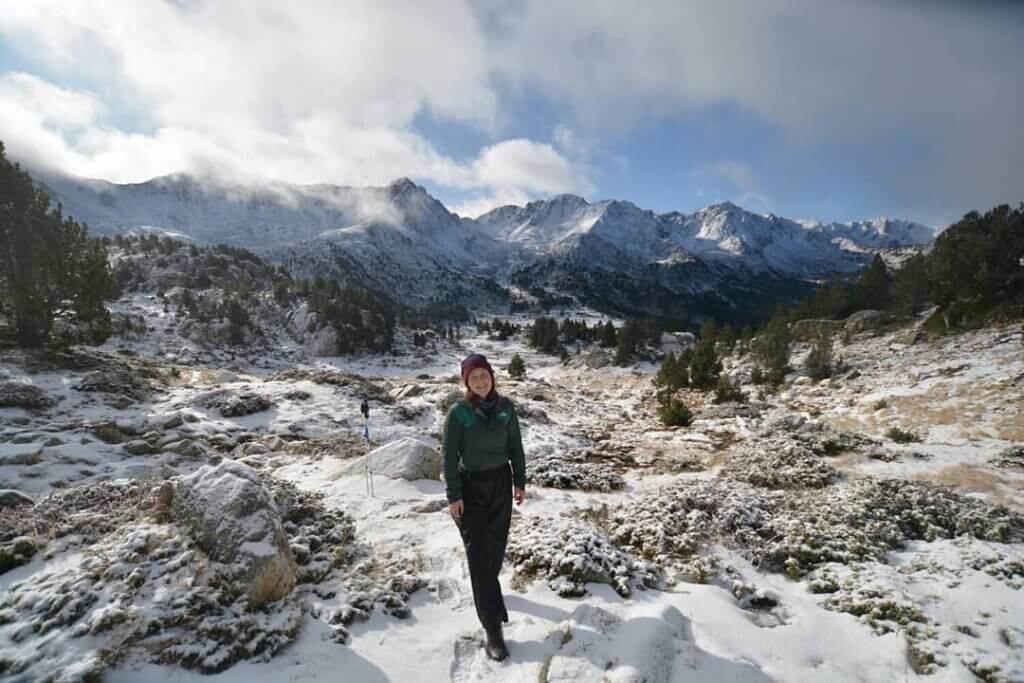
I am Beatrice. I am an artist and writer based in Scotland. Since co-curating the Rewind/Rewild exhibition and forum in 2019, I have been lucky enough to work with the Ramsay family from time to time on the creation of Bamff Wildland, in Perthshire.
I have written up the story of our meeting before but it is a good one and I think it merits repeating…
As part of the Rewind/Rewild programme, my co-curator, Anna Souter, and I were leading a number of schools workshops about extinction. At the point that the Ramsays walked in to see the show, a child had just challenged me to explain how the extinction of the dinosaurs was any great loss to humans. It was a good question and one that I did not have a ready answer for.
The Ramsays took themselves around the exhibition whilst Anna and I desperately tried to keep our class of nine year olds from bouncing in and out of the plinths and licking the glass vessels on the ground containing flourishing algae. At one point Anna made a grab for Rodrigo Arteaga’s deconstructed tree before it hit the deck. It was not the optimum time for talking to visitors but somehow, before leaving, Louise managed to find a moment to say, ‘You should come and visit us in Scotland. We’ve got beavers.’.
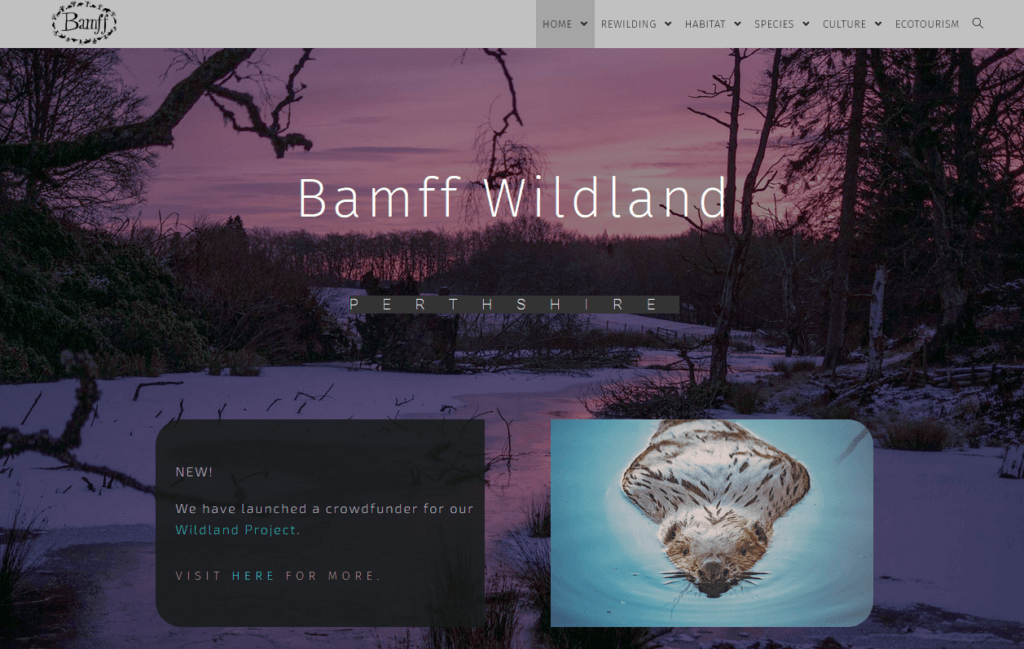
Even at the point of curating an exhibition and a public forum about human and non-human co-existence, I know little about beavers. I have recently moved to Scotland, lured by its mountains and walking potential, but now I am becoming increasingly familiar with having attacks of anxiety on bare Highland hillsides where I have found that nothing lives. So, when I step onto the Bamff estate on a hot May day some weeks later, I immediately notice the commotion. It is loud. The air quivers with the murmur of insect wings. Tens of tiny creatures land on my bare arms. Instinctively I brush them away, then I remember that I am advocating for biodiversity and I make an effort to stop doing that.
A friend has already warned me, in a hushed voice full of concern; ‘I saw a beaver habitat once and it was shocking. It looked like a war zone. All the trees were down, it was really heartbreaking.’.
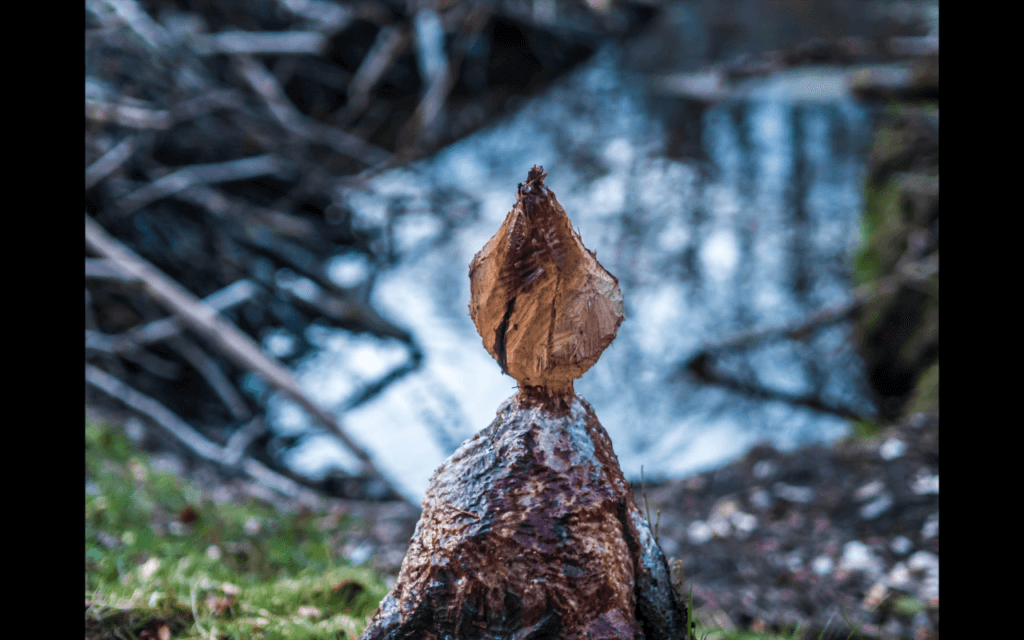
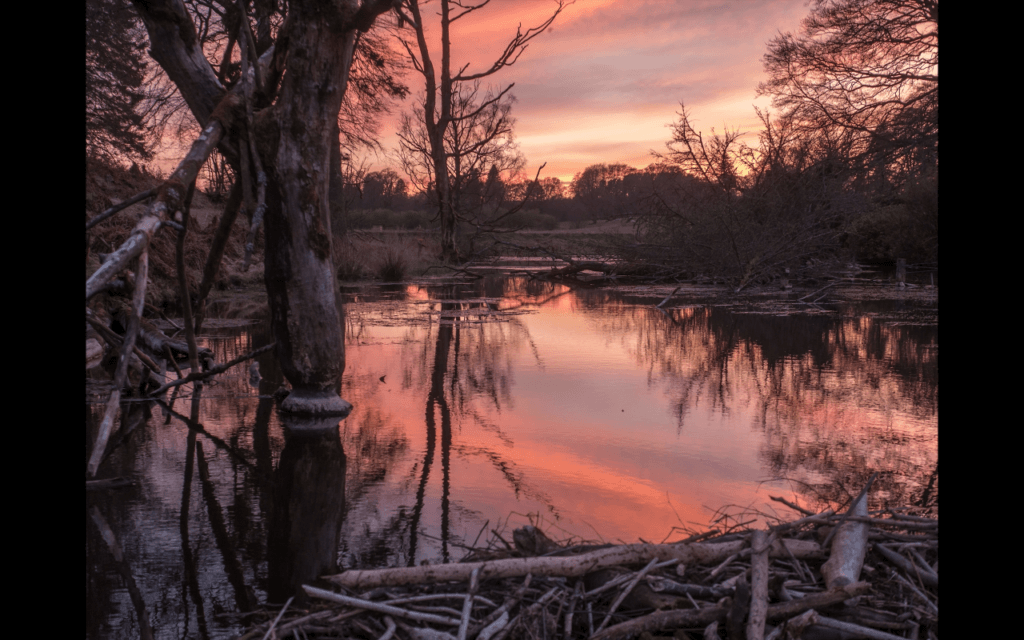
I look along the burn where wood lies saturated, where the grass either side is drowned and remaining trees rise directly out the water as though they were mimicking a tropical mangrove forest. Over the top of a substantial interlocked mesh of sticks and rocks, buttressed with mud, multiple rivulets have found their wiggling way over and into the pool below. This is my first sight of a beaver dam. Another occurs a little way downstream, and then another, a cascade of waterfalls that, taken as a whole, appear to me nothing less than a marvellous feat of engineering. Death and rot are present here, clearly visible, but still the air is diffused with flying creatures, new shoots reach from great downed tree trunks, and shelves of vivid orange and bright white fungi cling on to wet bark. Checkered sunlight filters through the birch wood that flanks the burn and falls on arrowhead shaped sculptures on the bank. This place is evidence, if evidence were needed, that a healthy, biodiverse, life supporting forest is vertical, diagonal, even horizontal at all stages of life, death and decay. This is nature’s way of recycling and fertilising. It might not be pretty, but it is better than that – it is vibrant, alive and majestic, supporting a massive range of invertebrates, birds and mammals.
Nowhere that I have yet known in Scotland, suffering as it is from the decimation of all but less than 5% of its ancient forests and the relentless persecution of its fauna, comes near to the wealth of life I have experienced since stepping out of the car five minutes ago.
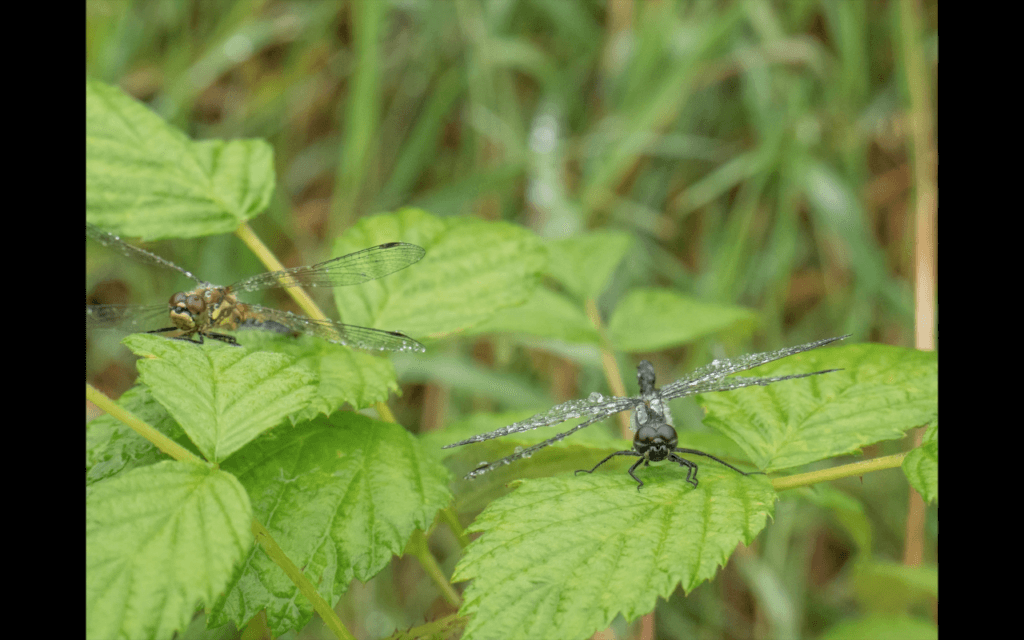
In the two years since I have had the privilege of tiptoeing along beaver dams, guided by an expert but nevertheless frequently misjudging my steps and plunging in up to my knees. Alone in the swamp I have gathered shards of wood scraped from the tree by powerful orange enamelled incisors, and felt a primordial thunderbolt of understanding that I hold magic in my palm. To be in a beaver habitat is to be in the presence of greatness. I have seen myself the coppicing effect that beavers induce in the trees they fell and sometimes, in the dusk, I see the beavers themselves, hefty and wide-hipped, pulling their slick bulk up over the dam and disappearing.
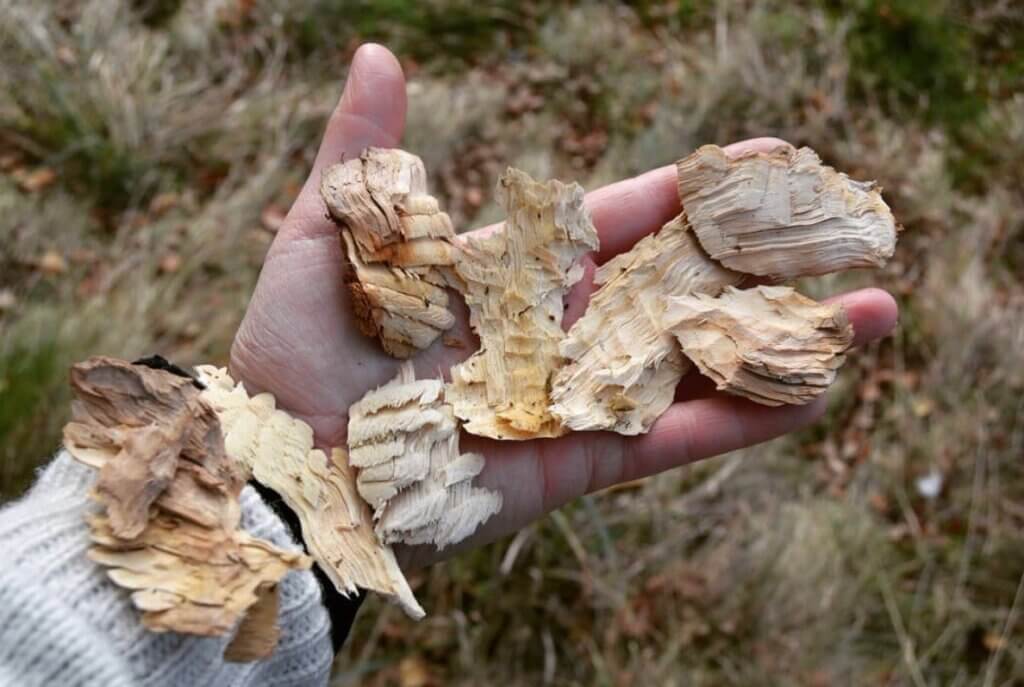
If you want to mitigate against floods and rising water levels in the face of climate change, improve water quality, tackle sedimentation, boost biodiversity, increase fish populations and prevent soil erosion, you ought to consider that beavers have been honing their crafts and solutions to all these for 12 million years. Beavers, the remedy for all ecological ills, sequester carbon in their ponds, filter and purify water and mitigate flooding by their dam building. By restoring natural processes in parts of the river catchment a natural flow pattern is achieved, slowing, cleaning and storing water and developing complex river habitats. Moreover, the dams created by the beavers will hold water in dry periods, help to lessen flash-flooding downstream and reduce erosion and improve water quality by holding back silt.
But actually, you do not have to take my word for it. The superb long distance walking route, the Cateran trail, goes right through Bamff. This, combined with the Scottish Outdoor Access Code, Bamff’s beautiful off (and on!) grid accommodation on site and their continued commitment to access means that there are more opportunities than ever to experience and be involved with the flourishing of this previously upland sheep farm as it goes even further than beavers…
Bamff now want to do more to address the biodiversity and climate crises, through a method called catalysed rewilding. This means making the minimum interventions possible at the start, to get nature back in the driving seat. Bamff intend to rewild over four hundred and fifty acres, in the style of the renowned Knepp Wildland in Sussex. Already the sheep have come off and, in January 2022, after a fallow year, twelve fields, six woods and some of the UK’s most impressive beaver territories will be transformed into a contiguous area of self-willed land, with conservation grazing from a small number of free-roaming cattle, pigs and ponies. This works because the ancestors of these native breeds (aurochs, wild boar and tarpan) co-evolved with our flora and fauna and, in low numbers, they have their vital place in a healthy ecosystem. Their rootling and browsing will allow a dynamic mosaic of diverse habitats and emerge from what was previously little more than a monoculture.
But to get such a project going requires no small amount of money. The first thing is to ensure that the stock can be contained in the Wildland and therefore put in place one large perimeter fence which will allow the internal fencing to come down. Then there is the purchase of the animals themselves, the monitoring by ecologists and experts on the impact of these changes on our diminishing biodiversity, copse planting to enrich the seed source, the digging of ponds and scrapes to attract back amphibians and nesting birds… the list of gentle interventions to catalyse the process, goes on…
And still, there is little to no government funding or support available for the kind of holistic approach being taken by Bamff. Considering the eyes of the world on Scotland at COP26 upcoming in Glasgow, considering that the State of Nature 2019 report found that biodiversity is declining at a faster rate in Scotland than anywhere else in the UK, it might be laughable if it was not so tragic.
As such, Bamff have recently launched a Crowdfunder campaign to spread the word as far and wide as possible, to raise the money needed to get some love into the ground and get this pioneering project off the ground! The Wildland is a project too radical to meet the funding criteria for the governments’s lacklustre approach at the moment. The Crowdfunder campaign is open for another 12 days, but already the public are demonstrating, with their money and their commentary on the page, what enormous public will there is for environmental restoration in Scotland. It seems that people are rooting for the reintroduction of the rootlers! The success of Bamff might yet persuade the Scottish government to support rewilding on marginal land to help meet the climate and biodiversity targets that they signed up to, in a way that is not only cost effective, but also joyful, with great, wild heart.
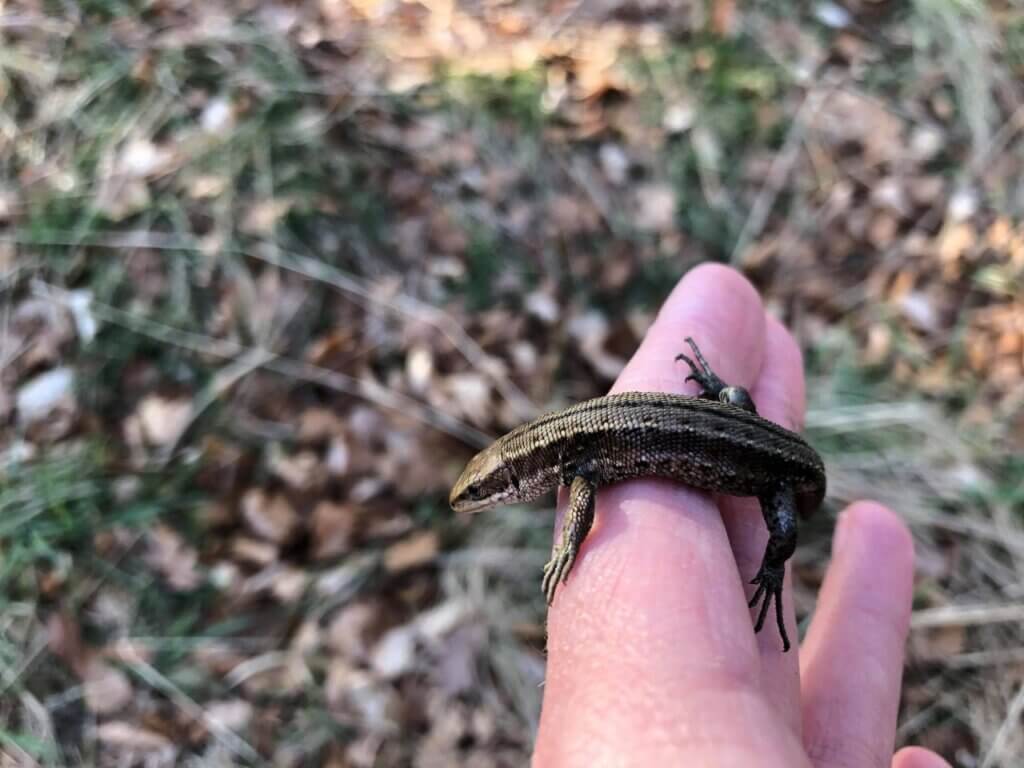
Today at Bamff I saw what I thought was a newt, hurtling through the beech leaves. By the time I asked Sophie for confirmation, I had hoped so hard for it to be a newt that I had convinced myself.
‘It’s a viviparous lizard‘, she tells me, ‘don’t worry – it’s rarer even than a newt; you’re honoured.’.
I really am, I think, as I creep along the river, closer to where two beaver silhouettes touch noses in the dark. And then there were the fieldfares at dusk today, and the bats that came soon after to share the air space. Getting to know Bamff has enriched my life enormously. So I have offered to hand carve, on wooden boards, the names of those who give to the Crowdfunder ‘Copses & Fence’ effort. Lettering in wood is not something I have been doing long. It is quite a different thing to my usual work; letter cutting in stone. But, come to think of it, my curiosity about cutting wood coincided with first finding the beaver’s tooth gouged scraps and the incised patterns they left on trees. More, far more breathtaking in rhythm and intuition than any letters I could carve. But then, to try to mark the strength of feeling for the Wildland in wood, with my human made chisels and my human hands, might be the closest I can reasonably come to an exchange, a collaboration, with Castor fiber. And I will take that opportunity.
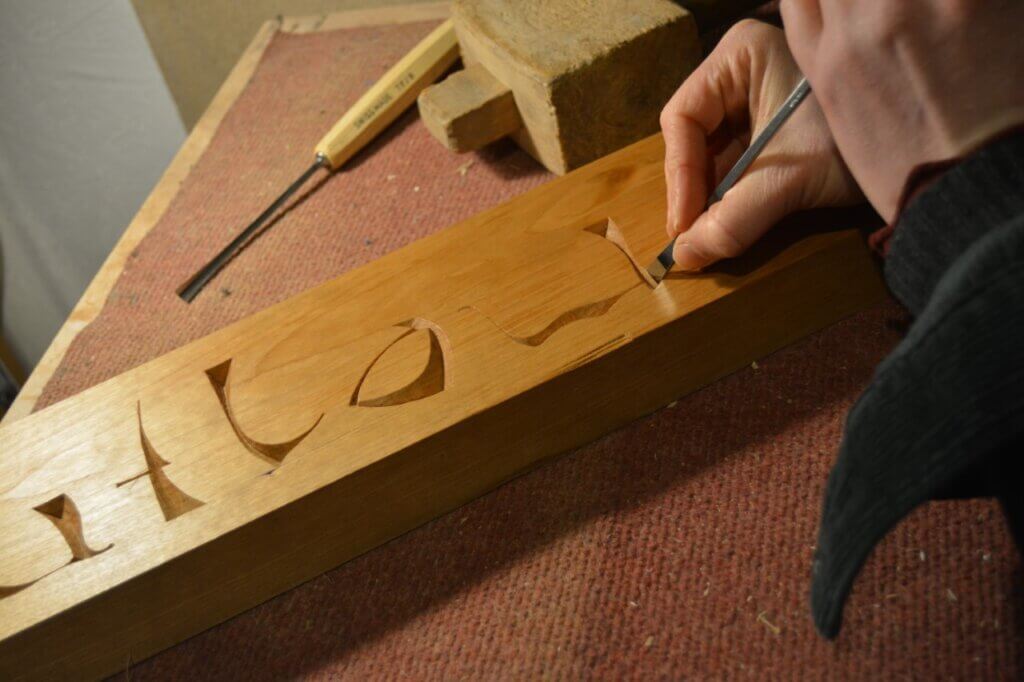
The Bamff Wildland crowdfunder is within £3000 of its initial target. Please consider giving it a helping hand – click here‘
[registration_form]
Beatrice that was magical, I’m rather jealous though as I’ve yet to visit Bamff myself. Not unexpected, but still alarming you have a friend that thinks what beavers create is heart breaking. There are those who not only hate the aesthetics of dead wood (while others have dead wood as a garden feature), but actually believe it will disease still living trees – how do they think forests have managed for three hundred million plus years without anyone taking it away? Of course as you note dead wood actually creates life, lots of it.
At present the virtually mandatory public consultation exercise for the ‘management’ of local woodlands is the absolute kiss of death for any dead wood even if somebody speaks up for it. If you (and the woodland) are lucky then at least some of the dead wood is piled under bushes out of sight of those who find it so objectionable – the poor dears – rather than burnt or hauled away. Something can still benefit from it, but the woodpeckers looking for invertebrates, the birds searching for nesting sites, bracket fungus, bats and butterflies looking to roost and hibernate among the peeling bark, rot holes and splintered ends left by fallen branches on standing dead wood are completely stuffed.
The very worst part of this is that even if any conservation body was involved in the consultation process they will have said and done ABSOLUTELY NOTHING to counter the antipathy, ignorance and even loathing that dead wood is the recipient of. I can only surmise they think even presenting the necessary information about the conservation value of dead wood is challenging those who want to get rid of it. That’s ridiculous, for one thing they have a duty to make sure they inform the public (and we have a right to be informed by other parties as of what is relevant, but were not aware of), for another it’s their bloody job and what I and others pay them membership fees for. Somehow if ‘community’, ‘public’ or ‘local’ gets attached to something it becomes sacrosanct, as in ‘the community consultation found…’ – the more ignorance there is, the less chance it will be fought.
There’s an awful lot of uninformed pressure to, or even unchallenged indifference that’s out there trying to turn our woodlands into glorified parks so that while the area of native woodland might be expanding the overall ecological health and wildlife value is plummeting for new and existing ones.
For a few years now I’ve been working on an initiative, a very simple (like myself) idea to counter public dislike of dead wood and in a way the laissez faire (non) approach the conservation orgs have towards it. Funnily enough it also involves carving text into wood, in this case to compliment imagery. Paul and Louise Ramsay know of it – although it was a while ago now – as I sent them an e-newsletter that had a handy description of ‘product’ and its application. Sadly the e-newsletter archives are no longer available. That’s one of the reasons I’m putting together a guest blog for this site about it, but mulling over how to do a good job of it isn’t easy especially for me . Your excellent article has helped set the stage for it though, and given my determination to finish it a boost – as you note lots of dead wood means lots of life.
One last thing you mention fieldfares at Bamff. Could these be migrant birds that have stayed over to breed, another species that responds particularly well to the presence of beaver? Anyway welcome to Scotland, we’re lucky to have you.
Hi Les,
Thank you for your comment. It’s very kind and you’ve taught me some more about dead and/or not quite vertical wood! I am not really qualified to answer your question about fieldfares but I did consult a bit with people who are and we think that the Bamff fieldfares are simply late leaving for Scandinavia to breed.
I would like to see your woodcarving on dead wood! So, as well as a life force for so much wildlife it seems it is also a rich inspiration for artists!
What a beautiful start to my weekend, reading this blog transported me into a magical wild land. Thank you for such an eloquent and insightful description of nature in action in this very special place. My heart longs to return to Scotland and with my parents in Perthshire and brother in Aberdeenshire I’m excited at the prospect of being able to visit this enchanted place sometime not too far away …… I’d love to bring the weans to Bamff and see the rewilding work of your resident beavers.
Amazing project and wishing you all the best in your continued rewilding efforts ….
Hi Elaine, thank you for your very kind comment! It really is magic at Bamff, and becoming even more so… I hope you and your children are able to see the Wildland for yourselves very soon!